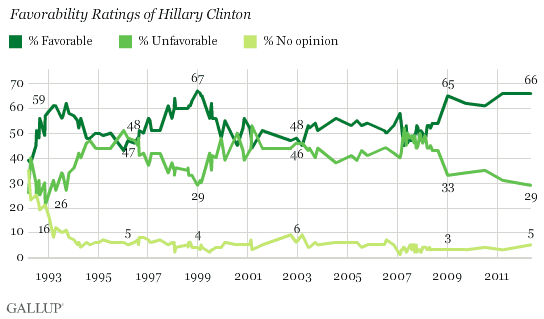PRINCETON, NJ -- Americans remain nearly as positive toward Hillary Clinton today as they have ever been over the past 20 years. The secretary of state's favorable rating remains at 66%, within one percentage point of her record-high rating in late 1998. Her unfavorable rating of 29% ties her record low since 1993.

Gallup's latest update of Clinton's favorable rating is from a USA Today/Gallup poll conducted May 10-13. Her 66% favorable rating, the same as she received in March 2011 and February 1999, is one point lower than the 67% high she reached in December 1998 just after her husband, President Bill Clinton, had been impeached by the House of Representatives. Her current 29% unfavorable rating is on the low end of the ratings she has received; her record low is a 21% unfavorable rating in 1992, but in that poll, more than one in five had no opinion.
Clinton's average favorable rating since 1992 has been 53%, but has undergone significant shifts over that time, as her public career has gone through four distinct phases -- her eight years as first lady, her service as U.S. senator from New York, a brief interlude during her campaign for the Democratic nomination for president in 2008, and, since 2009, her service in Barack Obama's cabinet as secretary of state.
Americans have been most positive about Clinton in her first few years as first lady; late in Bill Clinton's presidency, when he was being impeached on charges stemming from his affair with White House intern Monica Lewinsky; at times while she was serving as U.S. senator; and, most recently, in the 3+ years during which she has been secretary of state. These positive periods contrast with a number of occasions when her favorable rating dropped below 50% -- most recently when she was involved in the prolonged campaign against Obama for the Democratic nomination.
Clinton's favorable ratings have been above 60% in all five Gallup readings since January 2009, including the two 66% readings over the last two years -- thus representing the longest period of high ratings she has received since entering the national spotlight. Clinton receives a 91% favorable rating among Democrats, 65% among independents, and 41% among Republicans.
Bottom Line
Americans' opinions of Clinton have oscillated over the years as her political life has moved through a number of distinct phases. Ninety-five percent of Americans now know her well enough to have an opinion, and those opinions are more positive than negative, by more than a 2-to-1 ratio. It appears her ability to transcend domestic partisan politics as secretary of state, and her highly visible, extensive travels around the globe meeting with world leaders, have served to reinforce Americans' positive image of her. Previous Gallup analysis has shown that other U.S. secretaries of state, including Colin Powell, Condoleezza Rice, and Madeleine Albright, also had high favorable ratings while in that office, including Powell's favorable ratings, which were in the 80% range.
Clinton has said she will step down as secretary of state next year, even if Obama is re-elected. Although there has been occasional speculation that Obama might drop Vice President Joe Biden from the ticket and tap Clinton to be his running mate this fall, most of the discussion of her political future centers on the possibility that she would make a second run at the White House in 2016, when she will turn 69. The fact that Clinton is almost universally known and at this point well-liked by Americans suggests that she would be a formidable contender were she to decide to run. At the same time, the history of Americans' ups and downs in their ratings of her raises the possibility that if she were to jump back into the political fray, her image would have a significant probability of becoming more polarized and more negative once again.
Survey Methods
Results for this USA Today/Gallup poll are based on telephone interviews conducted May 10-13, 2012, with a random sample of 1,012 adults, aged 18 and older, living in all 50 U.S. states and the District of Columbia.
For results based on the total sample of national adults, one can say with 95% confidence that the maximum margin of sampling error is ±4 percentage points.
Interviews are conducted with respondents on landline telephones and cellular phones, with interviews conducted in Spanish for respondents who are primarily Spanish-speaking. Each sample includes a minimum quota of 400 cell phone respondents and 600 landline respondents per 1,000 national adults, with additional minimum quotas among landline respondents by region. Landline telephone numbers are chosen at random among listed telephone numbers. Cell phone numbers are selected using random-digit-dial methods. Landline respondents are chosen at random within each household on the basis of which member had the most recent birthday.
Samples are weighted by gender, age, race, Hispanic ethnicity, education, region, adults in the household, and phone status (cell phone only/landline only/both, cell phone mostly, and having an unlisted landline number). Demographic weighting targets are based on the March 2011 Current Population Survey figures for the aged 18 and older non-institutionalized population living in U.S. telephone households. All reported margins of sampling error include the computed design effects for weighting and sample design.
In addition to sampling error, question wording and practical difficulties in conducting surveys can introduce error or bias into the findings of public opinion polls.
View methodology, full question results, and trend data.
For more details on Gallup's polling methodology, visit www.gallup.com.
